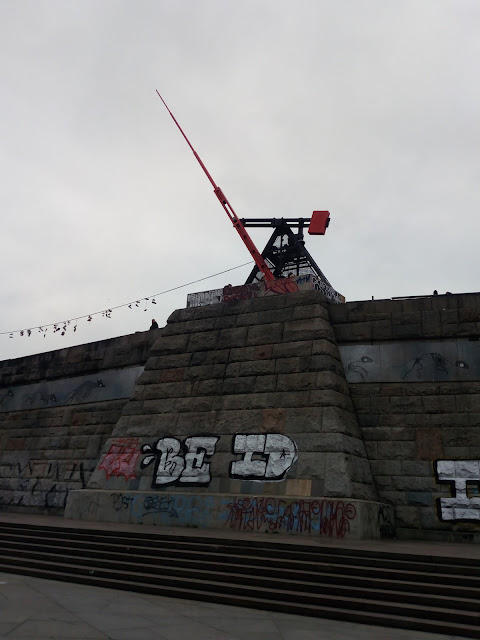Varasin talvilomareissun Suomeen, voitteko kuvitella. Maaliskuussa sitten nähdään. Alunperin ajatus oli mennä Kreikkaan, mutta tässä toinen voitteko kuvitella. Ei huvittanut. Ei yhtään huvittanut. Luin, että jos on jatkuvasti reissun päällä, voi tulla matka-burn out, jonka oireista tunnistin itseni ihan täysin. Ei vaan jaksa kiinnostaa. Kreikka on varmasti ihan mahtava paikka, mutta haluan mennä siine joskus myöhemmin, kun toivottavasti olen parantunut matkaväsymyksestäni niin, että pystyn oikeasti nauttimaan Kreikka-kokemuksestani. Joten varasin lennon Suomeen, koska siellä on ruisleipää ja Fazerin sinistä. Niin, ja perheenikin on siellä.
Hävettää tunnustaa, että yksi suurimmista motivaattoreista varata lippu Suomeen oli ruoka. Ei sillä, että Tsekin ruuassa olisi mitään vikaa, mutta kun ei ole ruisleipää. Eikä karjalanpiirakoita, ja suklaakin on epätyydyttävää, eikä ole mämmiä, vaikka pääsiäinen on tulossa. Siitä asti, kun varasin lennon, olen ilmoittanut äidille noin joka päivä jonkun uuden ruuan, jota haluan syödä sitten, kun menen Suomeen. Äiti kirjoitti menua tunnollisesti ylös ja totesi "tämä on nyt kahdeksas asia listalla, sinä et sitten vissiin muuta meinaa tehdä lomalla kun syödä" tai jotakin sinne päin. No en meinannu, en. Ja matkalaukussa vien 20 kiloo kotimaisia elintarvikkeita mukanani Tsekkiin, ostan arkkupakastimen ja täytän sen Vaasan ruispaloilla.
Joskus amkissa kulttuuritunneilla oli teemana se, mitä vaihtarit ja ulkomaalaiset tutkinto-opiskelijat kaipasivat kotimaastaan, ja melkein jokainen kaipasi ruokaa. Ei se ole ihan sama, mitä syö, kertoo tämä tutkimustulos. Itse huomasin Etelä-Koreassa opiskellessa, että aloin kaipaamaan ruokia, joihin en Suomessa halunnut koskea pitkällä tikullakaan. Esimerkiksi savulohi, jota olin koko elämäni syyttänyt päänsäryn aiheuttajaksi, alkoi yhtäkkiä vaikuttaa ruoka-unelmien täyttymykseltä. Ja kalasoppa. Ja moni muu asia, joita ei koskaan Suomessa ollessa tullut edes mieleen syödä.
Etenkin nyt tämän puolen vuoden aikana Tsekeissä olen huomannut, miten kovasti kaipaan ruisleipää. Tuntuu, että vatsaparassa on jatkuvasti pieni ruisleivän kokoinen lovi, jota ei mikään muu ruoka pysty täyttämään. Ruisleivän puuttuminen alkaa jo syödä elinvoimaa, joten on parempi mennä täydentämään varastoja. Suomalainen ruoka ei maailmalla ole erityisen tunnettua, eikä varmaan kauhean pidettyäkään, koska se on kauniisti sanottuna ainutlaatuista ja realistisesti sanottuna omituista. Siitä huolimatta päätin omistaa postauksen oudoille ruuille, joita tämä ulkosuomalainen ja varmaan muutkin samassa tilanteessa olevat kaipaavat.
1. Ruisleipä. Koska surullinen fakta on se, että samanlaista ruisleipää ei saa edes Ruotsista, vaikka onhan naapurienkin ruisleipä sentään parempaa kuin se, mitä manner-Euroopassa ruisleipänä myyvät, ja jossa on ruista eniten nimessä.
 |
| Kunnon aamiainen, josta ei tule paha mieli |
2. Fazerin sininen. Kyllä, suklaatakin olen kuullut usean kaipaavan. Nykyisin kuulun itsekin tähän makeanhimoisten surulliseen ryhmään. (Varmaan joku kuuli katkerat huokaukseni, äsken kun kävelin keittiöön kuorimaan appelsiinia, kämppikseni siellä tarjosi suklaata ja kuinka suunnaton olikaan onni ja ilo, kun se sattui olemaan Fazerin sinistä. Joku oli sitä asioikseen Suomesta tuonut.)
3. Suomalainen kahvi. Jota ulkomaalaiset ovat teeksikin haukkuneet, se kun tuppaa olemaan hieman laimeampaa kuin espresso-tyyppiset kahvit. Ja kahvi tulee tietenkin juoda Muumi-mukista. Tai jostain muusta kotimaisesta kupista.
 |
| Mörön makuista kahvia |
4. Karjalanpiirakat. Maailman todennäköisesti roisimman näköinen leivonnainen. Kunhan Suomeen menen, näitä urakalla leivon ja syön. Karjalanpiirakoiden tekeminen ei sinällään ole teknisesti kovin vaikeaa, mutta sähköuuni ei välttämättä kuumene tarpeeksi. Piirakat vaatii kovan lämpötilan, ettei niistä tule sitkeitä kuin tossunpohjasta. Näin ainakin kerrotaan.
5. Mämmi. (Jos karjalan piirakat näyttää eräältä toiselta piirakalta, niin mämmi näyttää siltä, että se on jo kerran syöty) Yritin ehdottaa äidille, että olisi ostanut jouluksi mämmiä, mutta ideani tyrmättiin, "koska nyt on joulu ja mämmi on pääsiäisruokaa ja johan minua hulluna pidettäisiin, jos joulun alla mämmiä kyselisin kaupasta".
 |
| Mämmiä... |
6. Salmiakki. Se nyt ei ole ruoka, koska se on ammoniumkloridilla maustettua lakritsia, mutta sitäkin on ikävä. Harmi, ettei kämppikseni kaveri tätä ymmärtänyt tuoda. Tai ehkä ihan hyvä vaan, salmiakin väärinkäyttö nostaa verenpainetta ja aiheuttaa epämiellyttävää läpätystä sydämen alueella. Esimerkiksi Japaniin salmiakki ei rantaunut, koska maan elintarvikeviranomaiset pitivät sitä ihmisravinnoksi kelpaamattomana. Jokainen voi miettiä omalta osaltaan, kannattaako siihen koskea.
7. Marjat. Mustikat, puolukat, karviaiset, viinimarjat, karpalot, lakat. Näin viime yönä unta, että istuin meidän puutarhassa kyttäämässä viinimarjojen kypsymistä, toivoin, että ne kypsyisivät, ennen kuin lentoni lähtee, mutta ne pysyivät sinnikkäästi raakileina. Tuttu toive myös valveilla olevassa maailmassa. Olen jäänyt paitsi karviaisten sadosta jo monena vuonna. Ja ruoka on ilmeisesti muodostamassa pienehköksi pakkomielteeksi.
Eikä se lista tähän lopu, mutta kirjoittaminen loppuu, koska tällainen ruuasta puhuminen aiheuttaa psykologisen nälän, joka johtaa ihmisen syömään, vaikka ei oikeasti tarvitsisi ja tiedättekös miten sitten käy. Niin, sitten lihoo. Niin kuin minulle tulee käymään tulevalla lomallani.














































